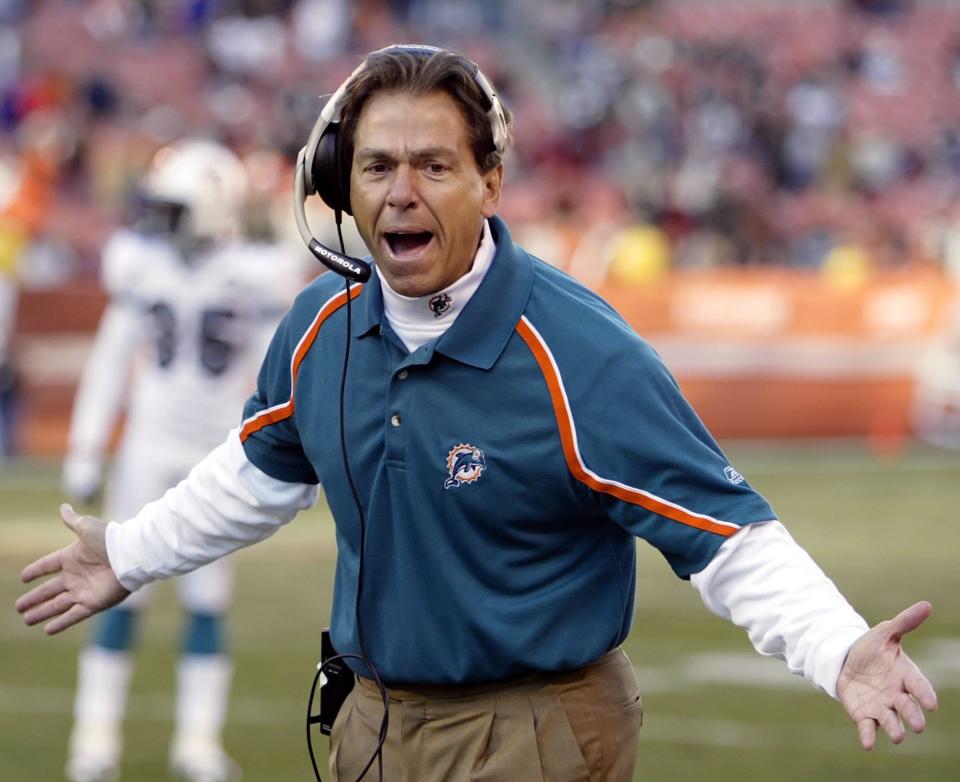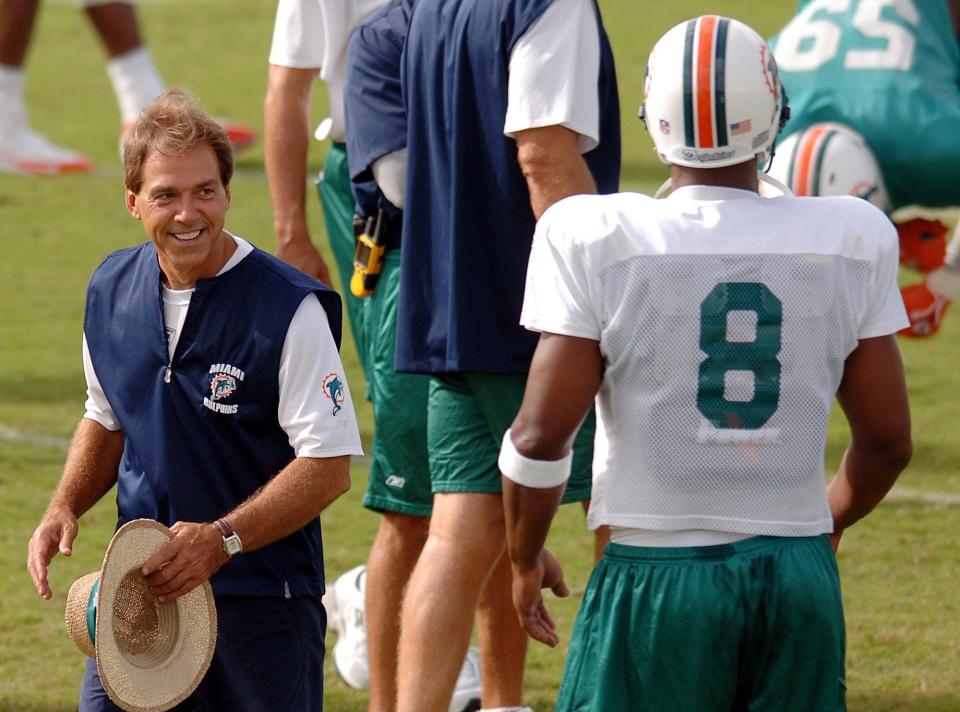Nick Saban is retiring as Alabama coach. Remember his ill-fated time as Dolphins coach?
Nick Saban is retiring as Alabama's football coach. And while he will go down as one of the greatest college football coaches of all time, his time as an NFL head coach will not be remembered fondly.
Saban coached the Miami Dolphins from 2005 to 2006, going 15-17 and never making the playoffs. From there, he would return to the college ranks and lead Alabama to become the powerhouse of the past decade, winning six national championships from 2007 to 2023.
Along with his 2003 title at LSU, Saban has won seven national championships, making him the most successful coach in college football history. His Crimson Tide teams won nine SEC championships and had undefeated seasons in 2009 and 2020.
But he couldn't reach that same level of success in the NFL. Here are five things to know about his time with the Dolphins.
Nick Saban came to Miami from LSU
Saban quickly built the Tigers into a national power after his arrival in 2000. He went 48-16 in Baton Rouge and won the 2003 national championship after beating Oklahoma in the Sugar Bowl.
Rumors lasted throughout 2004 of Saban leaving town. And that he did, leaving for the professional ranks on Christmas Day 2004 before LSU's New Year's bowl game to join the Miami Dolphins.
Saban had prior NFL experience coaching under Bill Belichick
The job with the Dolphins would mark Saban's return to the NFL, as he spent four years as defensive coordinator for the Cleveland Browns in the 1990s. He got the job from new head coach Bill Belichick, who had just gotten his first head coaching gig in 1991 after being defensive coordinator for Bill Parcells' Super Bowl-winning New York Giants teams.
Saban's defenses were mostly fine from 1991-94, reaching their peak in 1994 with the No. 1 scoring defense in the league. That team fielded six Pro Bowlers, led by All-Pro safety Eric Turner. Those Browns were Belichick's only winning team, going 11-5 and winning their wild card playoff game before losing to the Pittsburgh Steelers.
After that season, Saban took the Michigan State head coaching job. The Browns would leave Cleveland and become the Baltimore Ravens the year after that.
Saban had a successful first season with Miami

When Saban made his NFL head coaching debut, there were doubts as to whether his skills as a college coach would translate to the NFL. His tenure certainly got off to a rocky start as the Dolphins started the 2005 season 3-7.
With veteran Gus Frerotte as his starting quarterback, Saban's team struggled with scoring points in the early going. But things turned around after a 22-0 November loss to the Browns. Miami ended the season on a six-game winning streak, scoring at least 23 points in each game.
With Pro Bowl receiver Chris Chambers putting up 1,118 yards and 11 touchdowns and the running back duo of Ronnie Brown and Ricky Williams wearing out defenses, things were looking up for Saban's second season. All he needed was a front-line quarterback, and fortunately, one was available in free agency.
Fortunes turn when Dolphins sign Daunte Culpepper over Drew Brees

Unfortunately, the legacy of the Nick Saban era in Miami is remembered most for this oversight. Drew Brees was an unknown as a free agent in 2006 after tearing cartilage in his throwing shoulder the previous season with the San Diego Chargers. Meanwhile, fellow free agent Daunte Culpepper was also coming off a serious injury, tearing multiple ligaments in his knee in 2005 with the Minnesota Vikings.
The Dolphins decided Culpepper's injury was less worrisome and signed him, leaving Brees to go to the New Orleans Saints. Culpepper played just four games with the Dolphins, throwing for 929 yards and two touchdowns against three interceptions and being sacked a dazzling 21 times. The relationship between the team and quarterback grew contentious after that, leading to Culpepper's release in 2007.
With Joey Harrington as the primary quarterback, Saban's Dolphins went 6-10. Meanwhile, Brees threw for an NFL-leading 4,418 yards and 26 TDs with the Saints, good enough for an All-Pro spot and second place in NFL MVP voting. Brees and the Saints would win the Super Bowl three seasons later.
Saban leaves Dolphins for Alabama after saying he wasn't interested
As the 2006 Dolphins season imploded, rumors started swirling around Saban potentially leaving for the now-open Alabama job. The Crimson Tide fired Mike Shula, son of legendary Dolphins coach Don Shula, in late November, and Saban spent much of December battling questions about whether he was interested in leaving for Tuscaloosa.
"I guess I have to say it," Saban famously said at a news conference on Dec. 21. "I'm not going to be the Alabama coach."
On January 7, 2007, a week after the Dolphins' season ended, Nick Saban became the Alabama coach.
This article originally appeared on Treasure Coast Newspapers: Nick Saban retiring: 5 things from his time as Miami Dolphins coach

